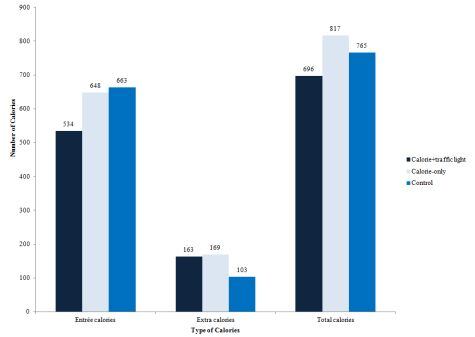The research, by Jayson Lusk and David Davis of Oklahoma State University and Brenna Ellison from the University of Illinois, was conducted in a full-service restaurant where patrons were randomly assigned one of three different types of menus when ordering lunch:
1 - The control: Menus with no information about calories.
2 - Menus with the number of calories listed.
3 - Menus with a traffic light symbol - red, yellow or green lights to indicate specific calorie ranges - in addition to a numeric calorie label. (Green for 400 calories or fewer, yellow for 401- 800 calories, and red for 800+ calories.)
Diners were then asked to complete a survey after the meal.
Calories and traffic lights more likely to impact choice of entrée than supplemental items
The calorie+traffic light menu label led to significantly fewer entrée calories ordered compared to the other two labeling formats (114 and 129 entrée calories fewer, on average, than the calorie-only and control menus, respectively).
Diners ordering lower-calorie entrée may feel they have a license to order an extra side or a dessert
However, diners choosing lower calorie entrées sometimes compensated by ordering higher calorie options as sides or desserts, said Dr Ellison. "The menus with the calorie labels alone actually increased total calories ordered by 52 calories, on average, compared to the control menu.
“This suggests diners who received calorie information may be experiencing a licensing effect such that ordering a lower-calorie entrée gave a diner license to order an extra side item or dessert.
"Diners receiving menus with labels may be rewarding themselves for 'good behavior' - ordering something lower calorie. If this is the case, that may be an unintended consequence of any labeling legislation."
Business or pleasure? Dining occasion also affects calorie consumption

However, the calorie+traffic light label still reduced total calories ordered by 69 calories, on average, compared with the control group.
Results also showed that calorie labels had the greatest impact on the least health conscious patrons, while using a symbolic calorie label further reduced the caloric intake of the most health conscious.
Meanwhile, patrons visiting the restaurant for a business lunch were more likely to make low-calorie choices than those eating with friends or relatives.
Not every diner has time to read - or wants to read - the number of calories listed for each menu item
They concluded: “Our results suggest that calorie labels in restaurants can be effective, but only among those restaurant patrons who have lower levels of health consciousness.
“Unfortunately, numeric labels did little for consumers who were already more knowledgeable about health and nutrition. To reach a broader group of diners, a symbolic calorie label may be preferred as it reduced caloric intake across all levels of health consciousness”
A symbol might be especially helpful in communicating with the broadest groups of consumers
Ellison added: "Not every restaurant diner has time to read - or even wants to read - the number of calories listed for each menu item.
“For this reason, a symbol might be especially helpful in communicating with the broadest groups of consumers.
“By reducing the number of calories ordered for diners across all levels of health-consciousness, the combination calorie-traffic light label seems to be more effective than the numeric calorie label alone."
Source: International Journal of Behavioral Nutrition and Physical Activity 2013,10:21 doi:10.1186/1479-5868-10-21
Title: ‘Looking at the label and beyond: the effects of calorie labels, health consciousness, and demographics on caloric intake in restaurants’, was published in the International Journal of Behavioral Nutrition and Physical Activity.
Authors: Brenna Ellison, Jayson L Lusk and David Davis
Click here to read it.
